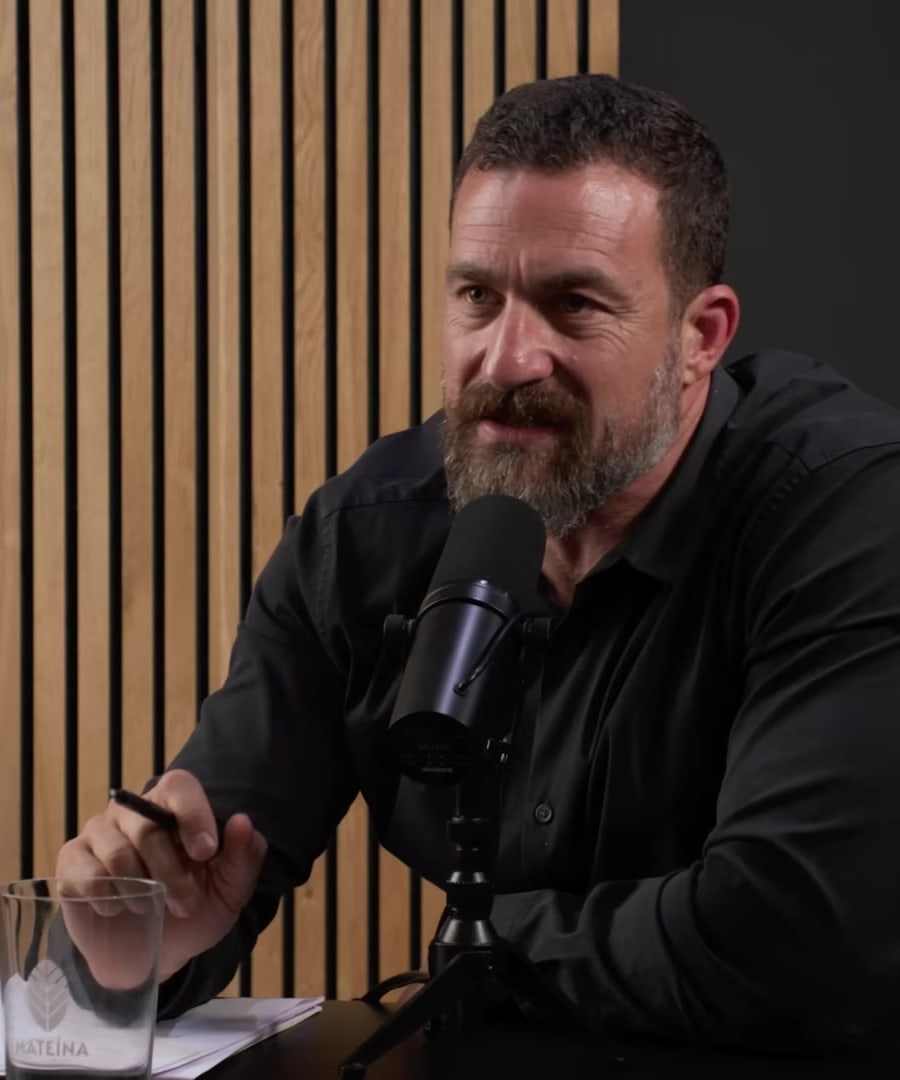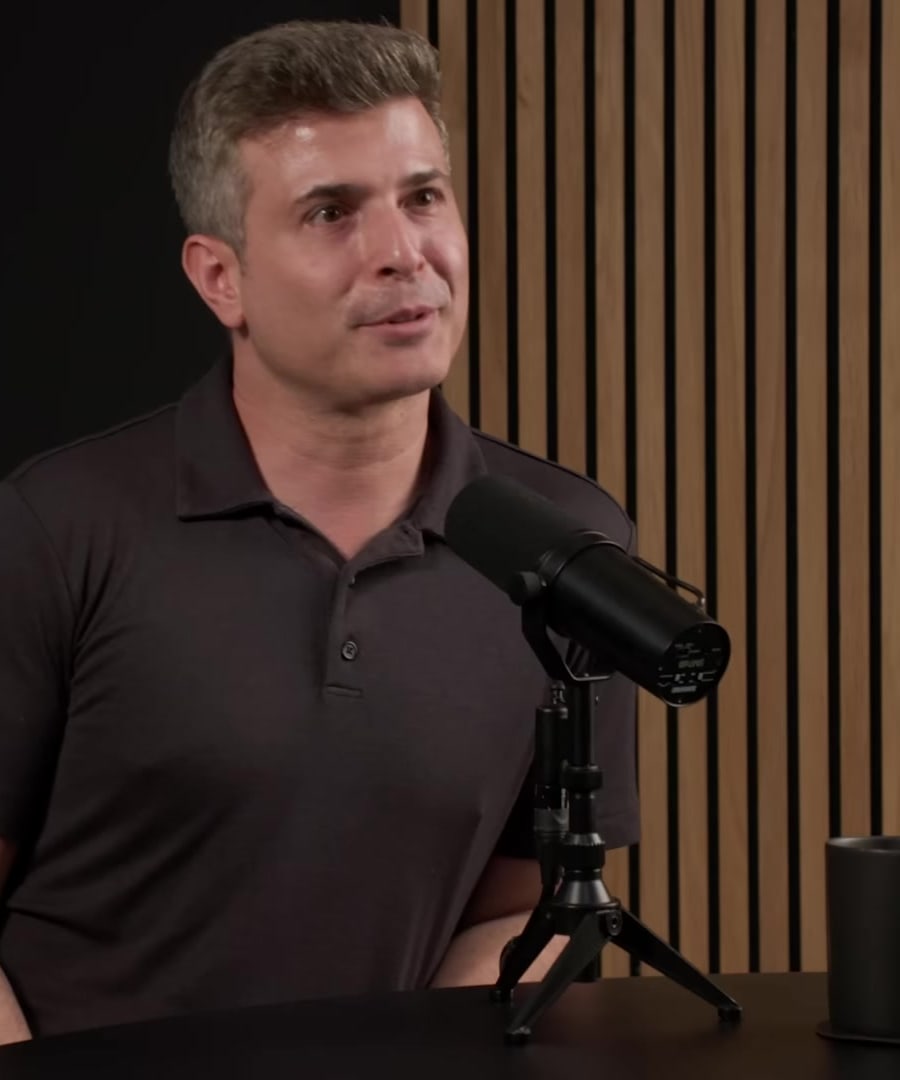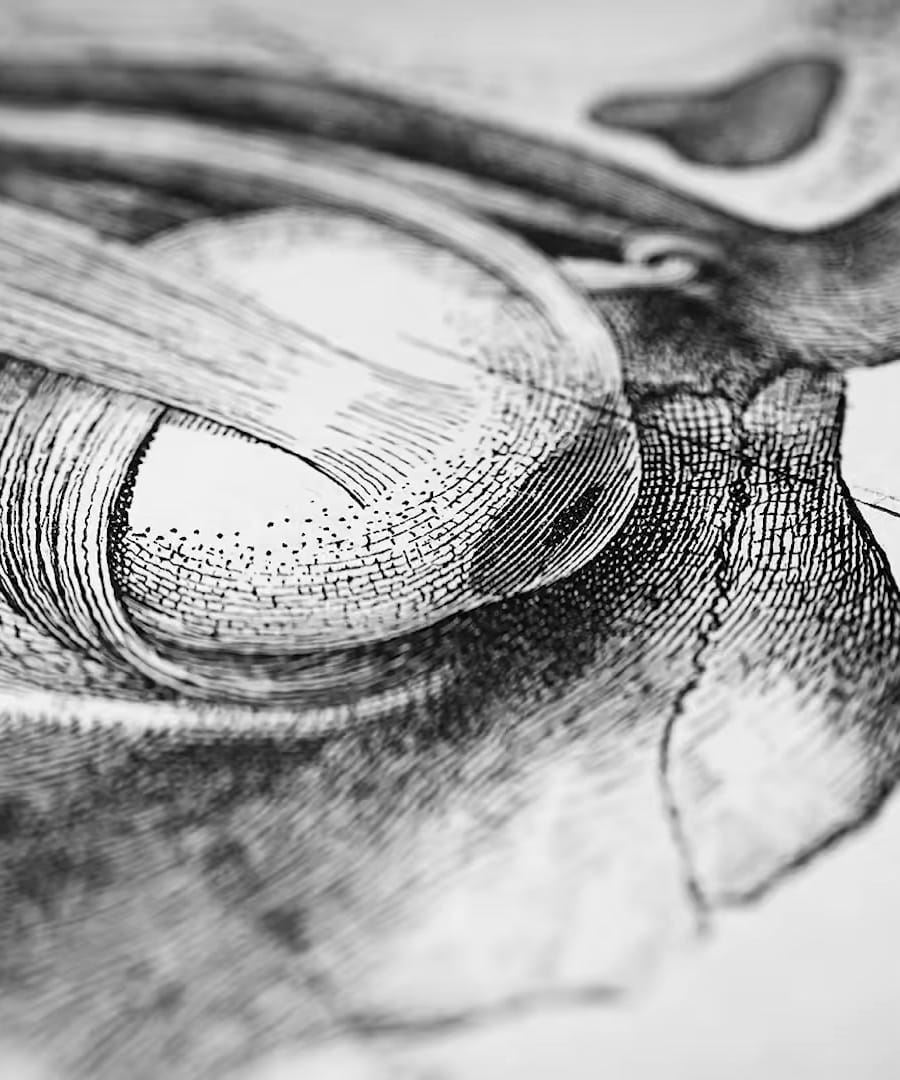learning
The , hosted by , is an excellent resource for exploring a wide range of topics including learning, mental and physical health, neuroscience, and many other fields. Each episode delves into scientific concepts and their practical applications, making complex ideas accessible to a broad audience. The podcast regularly features experts from various domains who provide deep insights into how to optimize health and performance.
RELATED QUESTIONSactive recall
Sources:
Active recall is a highly effective learning strategy emphasized by experts such as and . It involves the intentional recalling of information from memory, which strengthens memory retention and understanding.
shared how he revamped his study methods across different subject areas using active recall, stating he would test himself with a white piece of paper to see if he could perform certain tasks from memory, such as proofs in math. This rigorous method significantly improved his academic performance and led him to advocate for active recall through his writing, helping others achieve high learning efficiency 1.
In addition to Newport's insights, discusses similar techniques, such as reading material (be it scholarly articles or books), stepping away, and then trying to recall the learned information. He noticed a substantial improvement in retention and understanding by implementing this method, which is aligned with how the brain optimally learns 2.
RELATED QUESTIONStell me about fast learning
Sources:
Fast learning methods are discussed extensively by in terms of both theoretical understanding and practical strategies. Here are the key insights:
-
Focus on Errors: An essential part of efficient learning sessions involves focusing on errors without external cues. This allows learners to engage with their mistakes, and repeated practice of corrected movements or actions helps to solidify learning through neuroplastic changes 1.
-
Repetitions for Plasticity: It's crucial to perform as many repetitions as possible during learning sessions. This repetition helps to harness neurochemical mechanisms that reward small improvements, which reinforces learning and retention 1.
-
Mental Visualization: Mentally rehearsing skills can significantly boost the learning process. The pattern and timing of this mental rehearsal are crucial, with science showing that specific mental practices can lead to faster and more durable skill acquisition 2.
Each point underscores the importance of tactical practice and cognitive strategies in rapidly improving skills, from physical activities to cognitive performances.
RELATED QUESTIONS-
learning for school
Sources:
Learning effectively for school involves several key strategies discussed on the . Here are a couple of insights relevant to enhancing learning performance in educational settings:
-
Optimal Sleep for Learning: According to , sleep plays a crucial role in memory formation. Students who achieve adequate sleep before learning can experience a substantial increase in their ability to absorb and retain new information. Lack of sleep can lead to a 40% deficit in the brain's ability to make new memories. This insight underscores the importance of prioritizing sleep to enhance learning outcomes 1.
-
Listening to Body Signals: also discusses the broader understanding of our physiological and psychological responses impacting learning. Paying attention to the body's signals, like hunger, stress, or fatigue, can help students manage their health and maintain focus in learning environments. Acknowledging and responding to these signals can prevent burnout and promote long-term educational success 2.
Both sleep optimization and attentiveness to bodily cues are vital practices that contribute to better learning and overall academic performance.
RELATED QUESTIONS-
What are the best study techniques?
Effective study techniques are crucial for academic success. Here are some key strategies and insights highlighted in the :
-
Spaced Repetition: This involves reviewing information over increasing intervals of time rather than cramming. This technique leverages the psychological spacing effect, where longer spaces between review sessions lead to better long-term retention of information.
-
Active Recall: Engaging with the material actively rather than passively reading notes can greatly improve memory retention. This might involve testing oneself with flashcards or trying to recall key points from memory.
-
Interleaving Practice: Mixing different topics or types of problems during a single study session. This is opposed to practicing one kind of problem repeatedly and then moving on to another. Interleaving helps develop better problem-solving skills as it teaches the brain to apply knowledge flexibly.
-
Elaborative Interrogation: This involves asking oneself why something is true or how it connects to other knowledge. Creating these connections deepens understanding and recall.
-
Dual Coding: Combining verbal and visual information can enhance learning. For example, when studying a complex concept, students can benefit from reading about it and also looking at diagrams or other visual aids.
-
Optimal Learning Environment: According to , the environment in which one studies can significantly impact the effectiveness of learning. This includes factors like minimal distractions, adequate lighting, and even the room's temperature.
-
Regular Breaks: Taking planned breaks can help maintain focus over longer study sessions. Techniques like the Pomodoro method, where one studies for a set period (e.g., 25 minutes) and then takes a short break (e.g., 5 minutes), can help manage energy levels and improve concentration.
Each of these techniques leverages a different aspect of cognitive function and can be combined for a comprehensive study approach.
RELATED QUESTIONS-
What research supports these techniques?
It appears that there are no specific clips available as of now from the detailing the research backing the specified study techniques. In general, these methods, like spaced repetition, active recall, and interleaving practice, are supported by extensive educational research indicating their efficacy in enhancing learning and memory retention. These techniques are often discussed within the context of cognitive psychology and are typically validated through various empirical studies involving controlled experiments in educational settings. If more specific or detailed information becomes available in future episodes, it would be able to provide insights into the direct research findings discussed in the podcast.
RELATED QUESTIONSHow can I practically apply these techniques?
Sources:
To practically apply study techniques effectively, incorporating moderate exercise before engaging in cognitive activities can be highly beneficial. As discussed by , a study found that just 15 minutes of moderate exercise prior to tasks like the Trail Making Test significantly improved participants' energy, focus, and completion speed. The expected benefit involves not only an increase in physical energy but also an enhancement in cognitive focus essential for tasks that require active engagement, such as working with complex materials or problem-solving.
Practical Steps:
- Exercise Moderately: Before a study session, engage in 15 minutes of moderate exercise, such as a brisk walk or light cardio.
- Schedule Study Post-Exercise: Arrange your study sessions shortly after exercising to take advantage of the increased alertness and focus.
- Incorporate NSDR: After learning sessions, consider using Non-Sleep Deep Rest (NSDR) protocols like mindfulness meditation or yoga nidra to bolster neuroplasticity, enhancing the brain's ability to solidify new information 1.
RELATED QUESTIONSCan you provide details on one specific study?
Sources:
A specific study discussed by on nasal respiration and its effects on cognitive function was highlighted in the . The study, published in 2016 in the Journal of Neuroscience, is titled "Nasal Respiration Entrains Human Limbic Oscillations and Modulates Cognitive Function."
Study Highlights:
- Focus: The study investigated how nasal inhalation affects brain function compared to other forms of breathing, such as mouth inhalation or nasal exhalation.
- Key Findings:
- Nasal inhalation activates certain regions of the piriform cortex, which are part of the ancient neocortex.
- It also increases the activity of the hippocampus, a brain region involved in learning and memory.
- These effects contribute to improved memory retrieval and formation during nasal inhalation.
- Importance: The findings underline that the method of inhalation (through the nose) leads to increased brain activity in regions crucial for cognitive functions like memory and learning.
This study followed up on earlier research indicating that nasal inhalation improved recognition and discrimination of odors, emphasizing the specific impact of inhalation mechanics on brain functions unrelated to the sense of smell 1.
RELATED QUESTIONShow to Spaced Repetition
Sources:
The concept of "spaced repetition" and its effectiveness in learning was extensively discussed by in the context of what he refers to as "gap effects." Here's how it works and how you can apply it effectively:
How Spaced Repetition Works:
- Learning Phase: Initially, you are exposed to new information.
- Rest Phase: Following this, the actual rewiring of neural connections, necessary for solidifying the memory, generally takes place during rest periods, often during sleep. This phase might involve the rapid, reversed replay of the learning material which facilitates deeper encoding.
- Gap Introductions: Introducing gaps or breaks where no rehearsal or additional learning occurs can significantly enhance the encoding process. The brain, particularly the hippocampus, replays the information at an accelerated rate, aiding in stronger memory consolidation.
How to Apply Spaced Repetition:
- Schedule Learning Sessions: Spread your study sessions over a period of time rather than cramming. Implement short, focused sessions followed by breaks.
- Plan Rest Intervals: Incorporate longer rest periods after intense learning sessions, ideally including sleep, to enhance memory consolidation.
- Revisit Material: Regularly review material with gradually increasing intervals between sessions. This could be hours initially, then days, and eventually weeks.
By structuring your study sessions with these principles, you optimize your brain's natural processes for more efficient and durable learning 1.
RELATED QUESTIONShow to Active Recall
Sources:
Active Recall is a highly effective learning technique that involves testing yourself on the information you have learned without referring to your study materials. It strengthens memory retention and understanding by forcing the brain to retrieve information, which makes it a powerful study method.
How to Implement Active Recall:
-
Prepare Comprehensive Notes: Summarize your study material into main ideas and key points. This will be your reference for later recall sessions.
-
Create Recall Questions: Formulate questions based on your notes and materials that cover the breadth of the topics. These questions should aim to trigger deep thinking and connection-making.
-
Attempt to Recall: Without looking at your notes or books, try to answer these questions either verbally or by writing down the answers. This process forces your brain to retrieve the information.
-
Refer Back and Check: After attempting to recall the information, check your answers against your notes to correct any mistakes. This feedback loop is crucial for understanding and correcting any errors or gaps in knowledge.
-
Repeat Regularly: Regularly spaced recall sessions are necessary. Adjust the frequency of these sessions based on the results of your feedback checks. Increase the intervals between recall sessions as you become more confident in your knowledge.
-
Progressive Difficulty: Increase the difficulty of the questions over time to continue challenging your recall abilities. This could include synthesizing information across different sources or applying concepts in novel situations.
Cal Newport, a guest on the , shared personal testimony on how active recall transformed his academic performance. He emphasized its difficulty but noted its unparalleled effectiveness in learning and retaining new information systematically 1.
For a practical application, Newport described how in math classes he essentially tested himself by attempting to solve problems from scratch on a blank sheet of paper. This method helped him internalize complex techniques and ultimately excel academically 2.
RELATED QUESTIONS-
how to Interleaving Practice:
Interleaving practice is a learning technique where you mix, or interleave, different subjects or types of problems within a single study session. This method contrasts with blocked practice, where you focus on one topic or type of problem at a time.
How to Implement Interleaving Practice:
-
Identify Topics or Skills: Choose the subjects or skill sets that you want to interleave. These should ideally be related enough to challenge your cognitive abilities but distinct enough to require different approaches or skills.
-
Plan Your Sessions: Divide your study time into segments, allocating each to a different topic. The sequence should mix these topics in a way that varies from session to session.
-
Alternate Focus: During a study session, work on a topic for a predetermined amount of time or until a set number of problems or pages have been completed. Then, switch to a different topic, cycling through your predetermined subjects in the session.
-
Reflect on Connections: After completing your session, spend a few minutes reflecting on what was learned. Try to find connections between the topics. This could involve recognizing overlapping concepts, contrasting different approaches, or understanding how mastering one area can aid another.
-
Regular Review: Include review sessions that also use the interleaving method. This will reinforce the material over time and utilize the benefits of spaced repetition along with interleaving.
-
Adjust Based on Feedback: As you progress, adjust the complexity and interrelation of the topics based on how well you're retaining the material and performing in assessments.
Benefits of Interleaving Practice
Interleaving is particularly beneficial because it improves the ability to differentiate between concepts and apply the right strategies to the right problems. It also enhances long-term retention, making it a powerful learning strategy when dealing with complex subjects or multiple disciplines.
While there isn't specific information from the on interleaving practice at this time, this general guideline captures the essence of how to implement it effectively based on educational research.
RELATED QUESTIONS-
how to Elaborative Interrogation:
Sources:
Elaborative Interrogation is a learning technique aimed at enhancing comprehension and retention by prompting learners to generate explanations for stated facts. It involves learners asking themselves "why" a particular fact makes sense within a larger conceptual framework, which encourages deeper engagement and better understanding of the material.
Steps to Implement Elaborative Interrogation:
-
Identify Key Facts: Start with clear, factual statements from your study material that are important but perhaps not immediately comprehensible.
-
Ask "Why?": For each fact, ask yourself why this fact makes sense or why it is true. This question pushes you to integrate the fact with your existing knowledge.
-
Generate Explanations: Try to answer your "why" questions. If you can't, this indicates areas where your understanding is weak, signaling where you need to do more learning.
-
Refine and Repeat: As you develop explanations, refine them by checking against trusted sources or through discussion with others. Repeat the process to strengthen your understanding and aid recall.
-
Use Varied Resources: Support your elaboration by referring to different sources such as textbooks, lectures, or academic papers to ensure a robust understanding.
-
Practice Regularly: Make this questioning a regular part of your study routine. Frequent use of elaborative interrogation helps in solidifying memory and understanding.
Currently, there are no specific discussions on the "Elaborative Interrogation" method in the . However, these guidelines should help effectively implement this technique based on general educational strategies. For more specific neurological insights, checking resources that explicitly discuss cognitive science in relation to learning might be beneficial.
RELATED QUESTIONS-
how to Dual Coding
Sources:
The concept of Dual Coding involves utilizing both visual and verbal information to enhance learning and understanding. Dr. Erich Jarvis discusses an intricate example of this in the context of reading and writing. He explains how multiple brain circuits are engaged simultaneously: the visual cortex processes symbols from text, the Broca’s area in the motor cortex handles the silent speech of reading internally, and auditory pathways allow you to 'hear' the silent speech. Moreover, when writing, the hand areas adjacent to the speech pathway translate these auditory or speaking signals into written visual symbols on paper, effectively utilizing both visual and verbal pathways for communication [1]. This complex interaction supports the principles of Dual Coding by showing how intertwined and beneficial the use of multiple sensory modalities can be in learning processes.
RELATED QUESTIONShow to Optimal Learning Environment
Sources:
Creating an optimal learning environment involves several strategically applied aspects based on neuroscientific principles. Here are key insights and recommendations from to help enhance learning:
-
Peak Mental Acuity Time:
- Identify the time of day when your mental acuity is highest. Engage in learning activities during this period to maximize the effectiveness of error-making and learning from those errors. This creates an optimal neurochemical milieu for learning 1.
-
Engagement in Physical Activities:
- Engaging in physical activities such as sports can put the brain in a heightened state to retain new cognitive information afterward. Activities like playing tennis or shooting free throws before a cognitive task can enhance learning and memory 2.
-
Noise and Alertness:
- Your level of alertness influences how background noise affects you. If you're generally alert, a quieter environment is beneficial for learning. If you're often tired or low on arousal, some background noise might help increase alertness and improve learning efficiency 3.
-
Optimizing Work and Creativity Sessions:
- Schedule 90-minute intense focus or learning sessions throughout the day, anchored to your biology. This helps in expanding mental capacities and adapting to educational or creative tasks 4.
-
Workspace Optimization:
- Arrange the physical environment to maximize productivity and focus. This includes adjusting screens, using music strategically, and employing zero-cost tools like binaural beats to enhance learning and memory. Changing your workstation's arrangement and occasionally working in new environments can also heighten alertness and productivity 5 6.
These strategies, grounded in the understanding of neurobiology and cognitive function, provide a comprehensive guide to creating an environment that fosters optimal learning and cognitive engagement.
RELATED QUESTIONS-
how to Regular Breaks
Sources:
Taking regular breaks is essential for maintaining focus and productivity through a concept called "Deliberate Defocus." Here are the practices suggested by :
-
Duration and Frequency of Breaks:
- After about 45-90 minutes of focused work, take a break for at least 10-30 minutes. This allows your brain to replenish its metabolic energy, which is crucial for sustained focus and cognitive function 1.
-
Activities During Breaks:
- Engage in simple tasks that do not require intense mental focus. Avoid using your phone or other devices that can keep your mind active in the same way it was during the work session. Activities like taking a walk or engaging in light physical tasks are recommended 1.
-
Eye Relaxation Technique:
- For every 45 minutes of concentrated screen time, practice relaxing your eyes for at least five minutes. This can be achieved effectively by taking a walk outside and focusing on distant objects, which helps shift from focused to panoramic vision, relieving eye strain and enhancing overall focus readiness 2.
-
Mental Decompression:
- Deliberate decompression, where you allow your mind to idle and not focus on any specific task, is crucial for cognitive restoration. This can be particularly refreshing during breaks, allowing for a significant recovery of focus capabilities for subsequent tasks 1.
Implementing these strategies can help improve your cognitive performance and protect against mental fatigue. Regular breaks refresh the mind and are as crucial as the work intervals themselves.
RELATED QUESTIONS-
learning
- RELATED QUESTIONS
active recall
- RELATED QUESTIONS
tell me about fast learning
- RELATED QUESTIONS
learning for school
- RELATED QUESTIONS
What are the best study techniques?
- RELATED QUESTIONS
What research supports these techniques?
- RELATED QUESTIONS
How can I practically apply these techniques?
- RELATED QUESTIONS
Can you provide details on one specific study?
- RELATED QUESTIONS
how to Spaced Repetition
- RELATED QUESTIONS
how to Active Recall
- RELATED QUESTIONS
how to Interleaving Practice:
- RELATED QUESTIONS
how to Elaborative Interrogation:
- RELATED QUESTIONS
how to Dual Coding
- RELATED QUESTIONS
how to Optimal Learning Environment
- RELATED QUESTIONS
how to Regular Breaks
- RELATED QUESTIONS


















